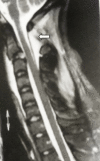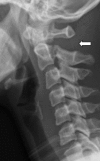Mechanically Relevant Anatomy of the Axis Vertebra and Its Relation to Hangman's Fracture: An Illustrated Essay
- PMID: 31261461
- PMCID: PMC6603824
- DOI: 10.14245/ns.1938140.070
Mechanically Relevant Anatomy of the Axis Vertebra and Its Relation to Hangman's Fracture: An Illustrated Essay
Abstract
To describe the biomechanically relevant anatomy of the Axis vertebra and the load transfer patterns within the bone, and on that basis, to postulate its mechanism of injury, a literature review was conducted of the anatomy and biomechanics of Axis fractures. Two hypotheses have been presented: the internal gear hypothesis and the leaf spring hypothesis. Both are based on the trabecular anatomy of the vertebra and its load transmission patterns. The relationship of the Axis with Hangman's injury is also discussed. According to the leaf spring hypothesis, the C2 pedicle corresponds to the shackle in the assembly and constitutes the weak link. The trabecular architecture of the Axis is such that the primary compression of the trabeculae is directed from the superior facet to the C2-3 endplate, with few trabeculae directed to the inferior facet. Along with the trabecular void in this area, this renders the isthmus vulnerable to trauma. The isthmus of the Axis is biomechanically susceptible to injury due to its unique anatomy in relation to the whole cervical spine and the internal load transmission patterns of the bone. The author suggests that in the flexion type of Hangman's injury, the C1-2 posterior ligaments are disrupted and need to be addressed.
Keywords: Axis vertebra; Biomechanical phenomena; Cervical vertebrae; Ligaments; Spinal fractures.
Conflict of interest statement
The authors have nothing to disclose.
Figures












References
-
- Stulik J, editor. Cervical spine trauma. Praha (Czech Republic): Galen Publishing; 2012.
-
- Benzel EC, editor. Biomechanics of spine stabilisation. New York: Thieme; 2015.
-
- Zdeblick TA, Benzel EC, Anderson PA, Stillerman CB, editors. Controversies in spine surgery. New Delhi (India): Jaypee Publishers; 2004.
-
- Korres DS, editor. The axis vertebra. Italia: Springer Verlag; 2013.
-
- Naderi S, Arman C, Guvencer M, et al. Morphometric analysis of the C2 body and the odontoid process. Turk Neurosurg. 2006;16:14–8.
LinkOut - more resources
Full Text Sources
Miscellaneous

